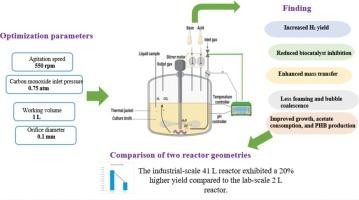可持续能源用生物水煤气变换反应制氢:关键参数影响预测
Q1 Environmental Science
引用次数: 0
摘要
开发可持续的制氢技术对于满足全球能源转型至关重要。在此背景下,本研究的重点是探索一种替代方法,即在厌氧条件下利用红红螺旋藻进行生物水气转换反应,作为生物制氢的潜在途径。该研究包括具体的影响关键参数对生物过程的性能,特别是在产氢率方面。主要结果表明,在较小的工作体积、较小的反应器孔直径、适当的进口一氧化碳压力和搅拌速度下,可以获得最高的产氢率。值得注意的是,与实验室规模的发酵罐相比,使用工业系统的氢气产量增加了20%。因此,通过预测模型获得的结果可以突出生物工艺作为一种有价值的途径的相关性,并作为工业生物制氢设计的真正指南。本文章由计算机程序翻译,如有差异,请以英文原文为准。

Biohydrogen production through the biological water gas shift reaction for sustainable energy: Prediction of the effect of key parameters
Developing sustainable hydrogen production technologies is essential to meet the global energy transition. In this context, the present study focusses on exploring an alternative which is, the biological water-gas-shift reaction using Rhodospirillum rubrum under anaerobic conditions as a potential route for biohydrogen generation. The study consists to concretizing the effect of key parameters on the performances of the bioprocess, especially in terms of hydrogen productivity. The main results show that the highest hydrogen productivity could be achieved when using a smaller working volume, a smaller orifice diameter of the bioreactor, and a moderate inlet carbon monoxide pressure and agitation speed. Noteworthy, it was found that there was a gain of 20 % in hydrogen production when using an industrial system compared to the lab-scale fermenter. Therefore, the results obtained by the predictive model could highlight the relevance of the bioprocess as a valuable route and as veritable guidelines for industrial biohydrogen production design.
求助全文
通过发布文献求助,成功后即可免费获取论文全文。
去求助
来源期刊

Bioresource Technology Reports
Environmental Science-Environmental Engineering
CiteScore
7.20
自引率
0.00%
发文量
390
审稿时长
28 days
 求助内容:
求助内容: 应助结果提醒方式:
应助结果提醒方式:


